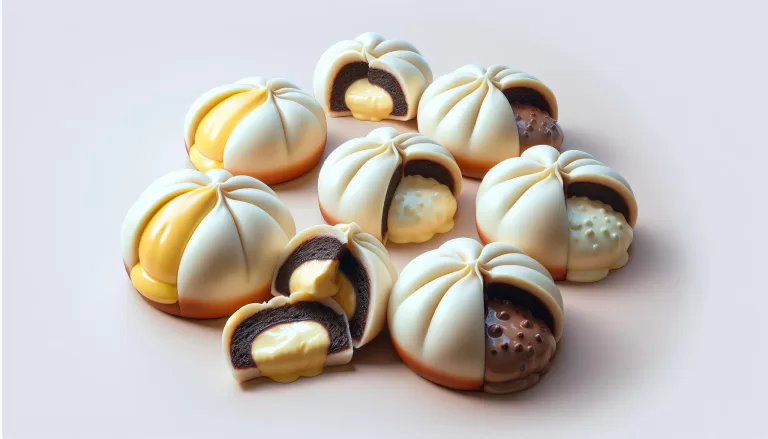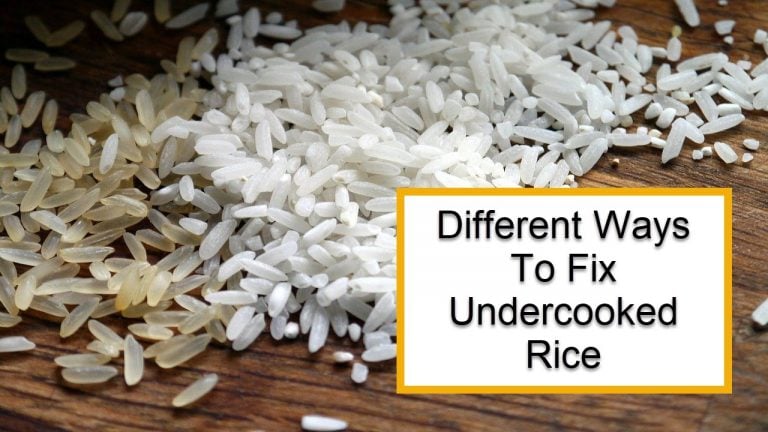Portuguese vs Chinese Egg Tart: What Is The Difference?
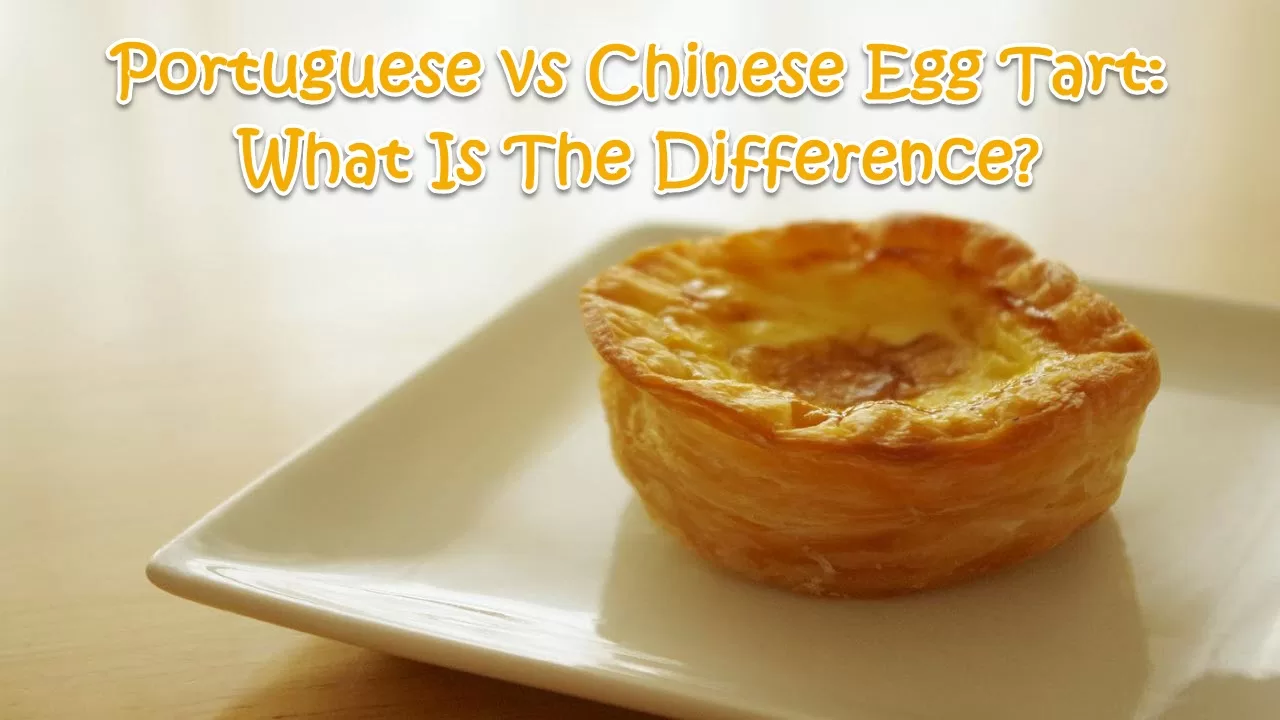
Do you love egg tarts? This article might pique your interest. We’ll talk about Portuguese egg tart and the Chinese egg tart.
In Asia, there are two desserts that are very popular, the Portuguese egg tarts and the Chinese egg tarts, or Portuguese custard tart and Chinese custard tart. From their Asian roots, they have spread throughout Europe and beyond.
If you love to learn more about these two delicious egg tarts. Scroll down and continue reading.
Portuguese vs Chinese Egg Tart
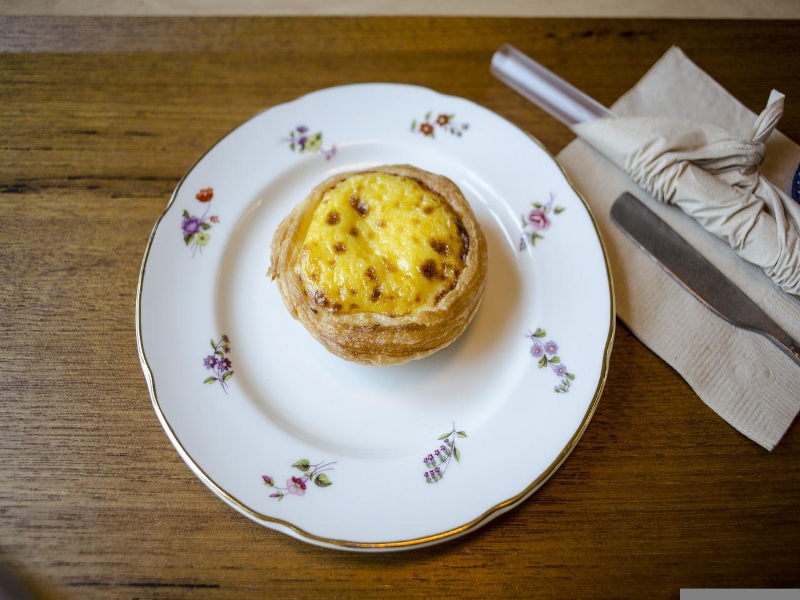
What Is An Egg Tart?
Let’s first define an egg tart before we move on to the main topic. The egg tart is a type of custard tart that may be encountered in Chinese and Hong Kong-style food and is a combination of English custard tart and Portuguese pastel de nata. The dish is made up of an exterior pastry crust and loaded with egg custard filling. In bakeries, cha chaan tengs, and dim sum establishments, egg tarts are widely marketed.
History Of Egg Tarts
Inspired by several varieties of European custard tart, the egg tart first became commercially available in Guangzhou (Canton), Guangdong province, in the early 20th century. Due to Guangzhou’s position as the primary port open to European foreign commerce, Cantonese food has been heavily influenced by other cultures. Pastry chefs at the city’s Western-style department stores were compelled to put up with fresh and innovative goods to entice customers, as Guangzhou’s economy expanded as a result of commerce and interactions with European powers. As a result, department shops produced various egg tart variations that were “Weekly Specials”, drawing inspiration from those from Europe and including a lard-based puff pastry crust and a filling comparable to steamed egg pudding. Currently, China produces mostly two types of egg tarts. Nearly all of the egg tarts eaten today in Guangzhou and Hong Kong originated in Zhen Guang Restaurant in Guangzhou around 1927. The pastel de nata has an impact on the other, which is from Macau, which at the time was a Portuguese colony.
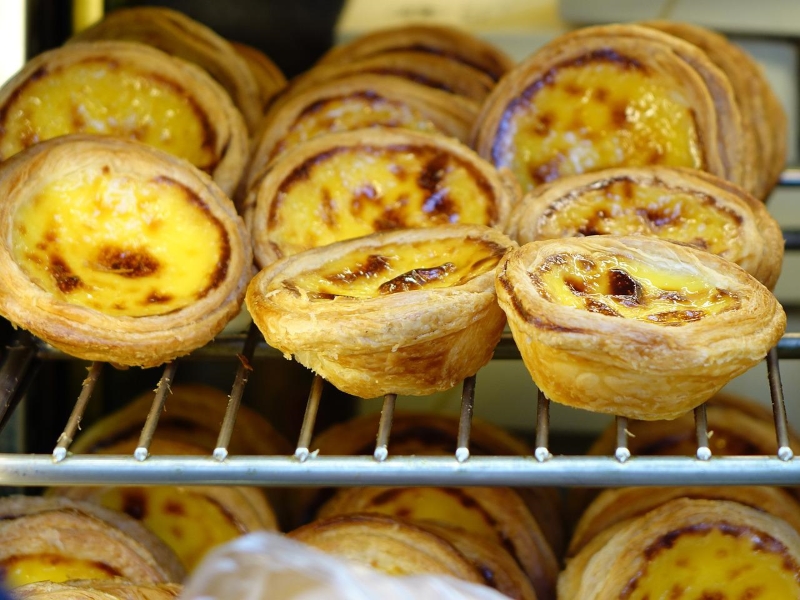
What Is Portuguese Egg Tart/ Pasteis De Nata?
Portuguese egg custard tart pastry known as pastel de nata may be sprinkled with cinnamon. They are especially well-liked outside of Portugal in other regions of Western Europe, Asia, and ex-colonies of Portugal, including Brazil, Mozambique, Macau, Goa, and East Timor. KFC also adapted the Macau egg tart or pastel de nata, which is now sold in places like China, Taiwan, and Hong Kong. This pastry is very well-liked in Indonesia, specifically in the Portuguese-speaking (Mardijker) neighborhood of Jakarta’s Kampung Tugu.
Portuguese custard tarts are a delectable, flaky pastry that is originated in Portugal, and spread to Macau where it quickly became a local favorite. The custard in these tarts, which are buttery, sweet, and baked until the tops are just browned, is aromatic.
Because of their gorgeously burnt custard, which is unusual for Asian desserts, and their buttery, flaky, and crisp crust, these treats stand apart from regular Asian sweets.
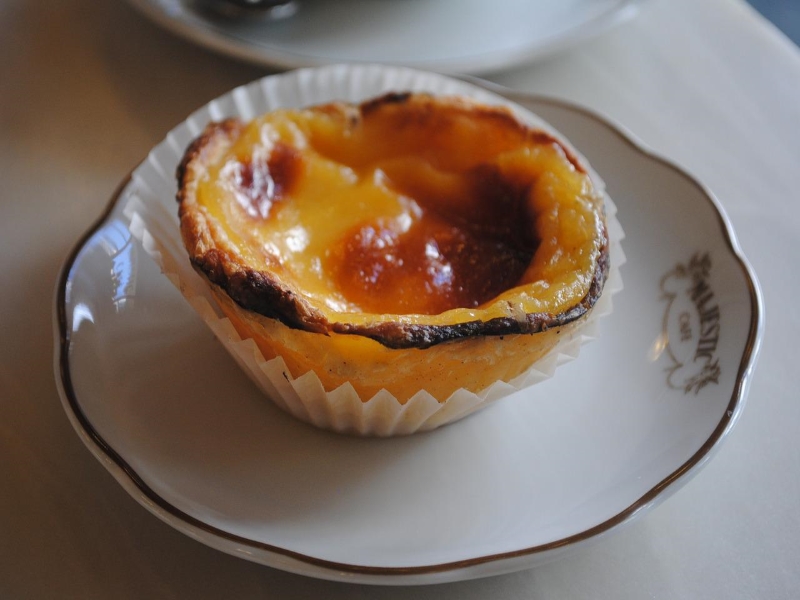
History Of Portuguese Egg Tart
You may be aware with Chinese egg tarts, but the Portuguese version, called pastéis de nata, is something quite different. Before learning about the Asian connection, it’s crucial to comprehend the history of pastéis de nata.
Prior to the eighteenth century, Catholic monks at the Hieronymites Monastery in Lisbon’s Saint Mary of Bethlehem civil parish (Portuguese: Mosteiro dos Jerónimos) produced pastéis de nata. Convents and monasteries at the period utilized a lot of egg whites to starch religious attire worn by friars and nuns. Recipes for sweet pastries developed across the nation as a result of monks and convents frequently using leftover egg yolks to bake cakes and pastries.
Following the Liberal Revolution of 1820, when religious organizations were dissolved and several convents and monasteries faced closure, the monks began selling pastéis de nata at a neighboring sugar factory to raise money. The formula was sold to a sugar refinery in 1834 when the convent was liquidated, and its new owners established the Belém Pastéis Factory in 1837. The company is still run by the descendants.
The original recipe for the pastel de nata has been kept in a secret room since the founding of Fábrica de Pastéis de Belém. The most famous location to purchase pastéis de nata is at the Fábrica de Pastéis de Belém, which is within a 3 minute walk from the Jerónimos Monastery. Over 20,000 pastéis de nata are sold each day at the store, which also provides takeout and seating options. The tart is typically topped with canela/cinnamon, and is served with a bica, a strong espresso coffee.
Macau Portuguese Custard Tarts
A short ferry trip separates Macau, a former Portuguese territory, from Hong Kong. Macau was returned to China in 1999.
The pastel de nata-inspired egg tart was produced at Lord Stow’s Bakery in Coloane, which was founded in 1989 by British pharmacist, Andrew Stow and his wife Margaret Wong. In Chinese, this variety is known as “Portuguese tart”. In 1999, Wong sold the formula to KFC, which then made the Macau-style pastel de nata available in Singapore and Taiwan, among other Asian countries.
Lord Stow left behind the Portuguese egg tarts, sometimes known as Macanese egg tarts, that are popular in Macau. In reality, he went by the name Andrew Stow; Lord Stow was a nickname. He first relocated to Macau as a pharmacist before using his expertise to develop a successful recipe.
The Macau-style egg tart has a caramelized browned top, unlike the egg tart made in Hong Kong.

Chinese Egg Tart
Actually, chinese egg tarts can be classified into a few different groups. These are egg tarts from Hong Kong and Macau, respectively.
In the 1940s, Guangzhou brought egg tarts to Hong Kong, but at first they were exclusively served in more upscale Western-style restaurants. Egg tarts gained popularity among Hong Kong’s working-class community in the 1960s when cha chaan tengs started serving them.
In contrast to the original Guangzhou egg tarts, which were larger and could be presented as a single dish, Hong Kong egg tarts often smaller and served in twos or threes. Shortcrust pastry or puff pastry can be used to make the outer shell, and the custard filling can be flavored with chocolate, green tea, abalone, or bird’s nest.
The egg tarts that we consume today are the product of Hong Kong’s enthusiastic adoption and adaptation of them. They are a cheap delicacy that you must taste if you’re traveling and are available at many bakeries.
The pastry used to make the casing has a wonderfully short crust that crumbles in your mouth. They taste best when consumed warm and right from the bakery. The filling is a vivid yellow egg custard. Flour, sugar, evaporated milk, margarine, and butter were the typical ingredients to make the pastry. The filling is made up of egg, sugar, evaporated milk, and water.
So What’s The Difference Between The Portuguese Egg Tart And Chinese Egg Tarts?
Unlike Portuguese egg tarts, which use puff pastry as their casing, these Chinese egg tarts from Britain are made with a short crust. A lighter filling and flaky crust characterize this Hong Kong egg tart. The Portuguese egg tarts are a delicate, melt-in-your-mouth treat as a result.
Additionally, Portuguese egg tarts are sweeter. Since the recipe was acquired from the monks, this makes reasonable. The Portuguese egg tarts are covered in cinnamon and lemon zest bits.
Portuguese Egg Tart Recipe
Ingredients
- 1/2 tsp salt
- 1 cup all-purpose flour
- 1/2 cup unsalted, softened butter
- 1/2 cup water
Filling Ingredients
- 1 lemon
- cinnamon stick
- 1/3 cup all-purpose flour
- 3/4 cup sugar
- 6 large egg yolks
- 1 1/2 cup whole milk
- 1 tsp vanilla extract
- 1/8 tsp salt
Instruction In Making The Dough
- To make a rough dough, combine salt, flour, and water in a large bowl. It typically requires 5 minutes of kneading to get it to a highly sticky state. Let it sit for about 30 minutes while it is covered in plastic wrap.
- Prepare a work area with flour. Place your dough onto the work surface, sprinkle it with flour, and roll it out with a rolling pin. It should be rolled into a one-foot square.
- Now, think of three columns. Butter the left and middle column, leaving a border of a half inch on all sides. Right column should then be folded over middle column. After that, fold the left column over it. You can move on to the following step once you have it turned counterclockwise. Once more, repeat this twice. Leave a half-inch border around it as you apply the remaining butter.
- Rotate it once more, then roll it tightly from bottom to top. As you move along, be mindful to sweep up any extra flour from the bottom. If the edge is dry when you reach the end, it will stick. The log should be split in half after trimming any extra dough from the ends.
- One of these can be chilled for an hour, and the other can be frozen for the next batch that you’ll definitely want to make.
Instructions In Making The Filling
1. First, you need to grate the cinnamon and make a lemon zest.
2. Then, create a syrup out of the cinnamon by heating it with the sugar, 1/4 cup of water. Keep the temperature at 225 °. Stir everything up, then add your lemon zest and let it sit for 30 minutes.
3. Next, turn on the oven to 500 ° and place a baking sheet inside.
4. In a bowl, stir together your flour, salt, and half a cup of milk until well combined and smooth. Once the remaining cup of milk has reached a rolling boil, stir in your flour mixture. Stir over medium heat until it’s creamy, thick, and smooth, this will usually take for about five minutes.
5. Then, strain your syrup through a sieve into your milk mixture. Add egg yolks and vanilla by whisking them into the batter.
6. Cut the refrigerated dough into twelve slices measuring half an inch. On a 12-cup muffin pan, push each slice firmly into its individual cup until the dough is halfway up the muffin cup. Each shell should have two tablespoons of filling.
7. On the baking sheet that has been warmed, place the muffin pan in the oven. Bake the custard puffs and turns golden brown. In about 15 minutes, the crust will be a beautiful, brown, delectable pastry puff.
8. After that, allow to rest for 10 minutes, then Take them out of the muffin tray. Prior to serving, let it sit for another 20 minutes.
Hong Kong Egg Tart Recipe
- 2 cups all purpose flour, fluffed and spooned into measuring cup
- 1/2 cup evaporated milk
- 1/8 teaspoon salt
- 12 tbsp unsalted butter, slightly softened
- 2 tbsp cold water
- 1/2 cup granulated sugar
- 1 cup hot water
- 1 tsp vanilla extract
- 3 large eggs
Instructions
1. Combine the flour and salt in a bowl. When pressed, the butter should yield, but it shouldn’t be too soft to the point that it collapses. Basically, you want it soft enough already to break up with your fingers, but it shouldn’t instantly turn into a paste when combined with the flour.
2. Next, slice the butter into small cubes, and combine it to the flour and salt. Working rapidly, roughly break it up with your fingertips until it resembles coarse crumbs and contains some pea-sized butter bits.
3. With your hands, combine the dough with 2 tablespoons of cold water. If more water is required, add it gradually, no more than 3 teaspoons at a time. The dough will be scraggly and dry at this point. To continue absorbing moisture, the flour in the dough needs time to rest in the refrigerator. Refrigerate the dough for 20 minutes after carefully wrapping it in plastic or a reusable bag.
4. Roll the dough into an approximately 6 by 15-inch rectangle on a surface that has been lightly dusted with flour. Avoid overworking it, so you should work rapidly.
5. Fold the dough in thirds: top to center, bottom to top, and top to bottom. Roll out the dough once more to a 6 by 15 inch rectangle after giving it a quarter turn (to the left or right). Repeat the previous folding method, cover, and chill for an hour.
6. Next, prepare the filling while the dough is resting. 1 cup of boiling water and sugar should be dissolved and let the mixture to cool at room temperature. Eggs, vanilla, and evaporated milk should all be whisked together before adding the sugar water. Strain into a sizable measuring cup or pitcher using a fine-mesh strainer. You should have two to two and a quarter cups of custard.
7. Now, preheat the oven to 375°, and place a rack on the lower third of your oven.
8. To fit either mini tart tins or a shallow non-stick regular muffin pan, roll out the dough to a thickness of 0.2 inches or 5 mm and cut it into rounds measuring 4 inches, leaving a lip that extends over the top of the cup. Once you have about 16 circles, reroll the leftover dough and cut more of them.
9. Aim for a three-quarters filling of the tart shells evenly. If the dough lip at the top is large enough, you can fill it up to the point where it curls outward.
10. Once full, place the pan in the oven right away, very gently and cautiously. As soon as possible, lower the temperature to 350°, and bake for more or less 30 minutes, or until the filling is just set and a toothpick can be inserted, and can stand upright in it.
Before eating, let the tarts cool for at least 10 minutes.
